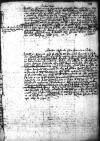Letter #3415
[Ioannes DANTISCUS] to Stanisław HOZJUSZ (HOSIUS)Heilsberg (Lidzbark Warmiński), 1548-07-19
Manuscript sources:
Auxiliary sources:
Prints:
| ||||||||
Text & apparatus & commentary Plain text Text & commentary Text & apparatus
Venerabilis etc.
Quid nomine spectabilis
Quae feliciter valeat.
Dat(ae) or Dat(um)⌈Dat(ae)Dat(ae) or Dat(um)⌉
ex Arce nostra

 AAWO, AB, D. 70, f. 373r
AAWO, AB, D. 70, f. 373r